Beyond Project Alloy: We reveal how Intel’s quietly betting big on the future of VR
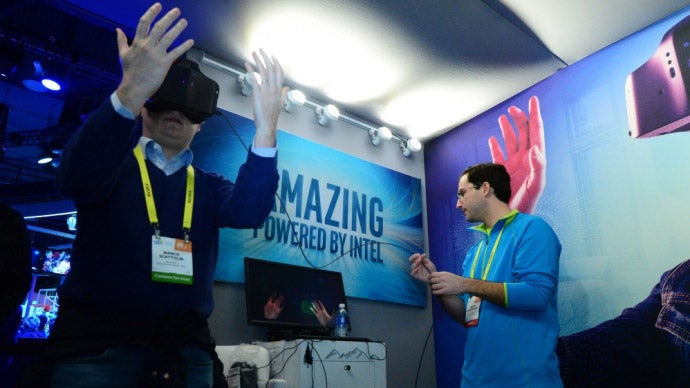
Intel’s Kim Pallister reveals how the company plans to make its mark in the VR industry, despite seemingly lagging behind well known virtual reality players like Samsung, Oculus and HTC.
For a company that doesn’t make a VR headset or have any kind of headline virtual reality technology, Intel is mightily ambitious and enthusiastic about all sorts of artificial reality, be virtual, mixed or augmented.
Its commitment to the emerging industry was obvious as soon as I saw its booth at the Game Developers Conference (GDC) in San Francisco, which was strikingly situated on the supervillain-style Sky Bridge in the Moscone Center and featured a mix of VR games and devices.
But I wasn’t there merely to ogle, or pretend I was auditioning to be the new James Bond – I was there to meet Kim Pallister, who heads up the Intel VR Center for Excellence and is likely the biggest virtual reality advocate in the company.
Obtuse naming aside, this division is the heart of Intel’s VR strategy, and is tasked not only with staying abreast of the latest VR trends, but testing every bit of hardware and software that’s released on to the market – a job that sounds like a whole lot of fun to you and I, but actually has its pluses and minuses.
Related: Best VR headsets
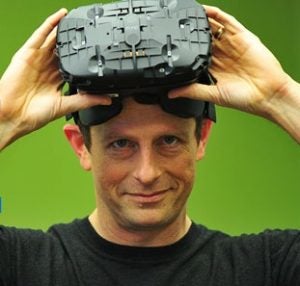
As Pallister told TrustedReviews at GDC:
“The engineers on my team spend a lot of time in VR, and unfortunately they spend a lot of times in systems that are half broken and not working and making themselves sick. It’s kind of a running gag. We’ll look at low-cost solutions coming out of China and what have you, and it’s not always the best stuff we’re looking at.”
There are also plenty of perks though, like getting early code for upcoming VR titles, and the fact that – the odd bit of motion sickness aside – yes, Pallister ultimately gets paid to spend (at least part of) his day trying out virtual reality gadgets. But there’s lots more serious stuff to get done.
I spoke to him about the current state of the industry, what’s coming up next, where Intel fits into the VR puzzle, and what it might mean for PC gaming as a whole. Here’s what I learnt.
Why VR needs to achieve critical mass
One thing that’s currently noticeable in the VR industry is that every company, from the hardware manufacturers down to the developers, has to work together to keep the hype train moving – traditional tech rivalries are being put aside, at least for now.
Also, despite the big headlines that the Oculus Rift and HTC Vive make, PC-based VR is a still a nascent market dominated by enthusiasts. The industry still has a long way to go to achieve critical mass, which is the goal for Pallister.
“Bringing VR to new segments and new consumers, helping get things standardised so prices come down and there’s more innovation, that’s very bread and butter stuff like what we do with the PC industry as a whole,” he told me.
Pallister continued: “
That’s standard VR industry rhetoric, but unlike the companies you immediately associate with VR, Intel appears to be happy with taking a back seat, influencer-cum-advocate kind of role – at least for now.
Gaining ground behind the scenes
The fact that Intel’s first foray into in-house VR tech only arrived last year with its Project Alloy concept is telling, but then it knows a thing or two about winning formulas and has never been an overly ‘in your face’ brand like some other big tech companies.
Its ultimate aim is surely to replicate the success of its Core i processor line in the virtual reality market, with partners and VR hardware manufacturers proudly displaying their Intel credentials in the same was as laptop makers advertise their Intel internals – CEO Bryan Krzanich say he expects hardware makers to be producing Alloy-like products before the end of 2017.
Related: Best Intel processor – Core i3, i5 and i7 explained
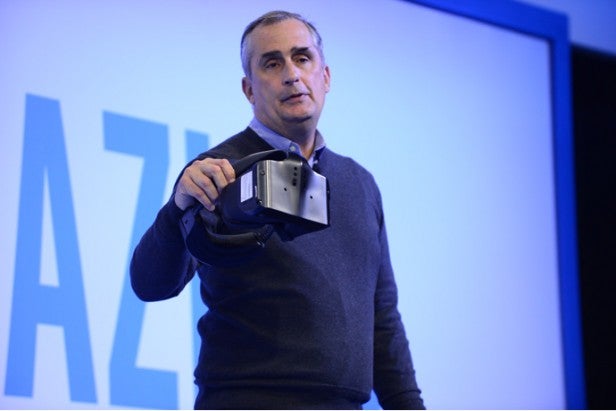
Above: Bryan Krzanich, Intel CEO | Image credit: Intel
It’s essential, then, that Intel keeps up to speed, but what you might not know is that it’s already armed with a vast arsenal of components and technologies – from CPU chips to wireless chips, sensor chips and 3D audio software – just gagging to be used in VR.
In fact, we’re already starting to see a number of applications, with Intel’s highest-end CPUs now being marketed to VR content creators. Elsewhere, high-speed WiGig wireless chips have the potential to go into the next generation of wireless headsets, while RealSense cameras are a key ingredient of so-called ‘mixed reality’ headsets.
To miss out on an opportunity to stick its tech expertise into VR wouldn’t go down very well back at base.
“You give this stuff to developers and they will do magical stuff with it,” Pallister notes.
Another topic that comes up time and time again in my time with Pallister is wireless VR. Just this year, HTC has started toying with external peripherals that hook up to the Vive headset to allow it to ditch its wires (and gain a massive external battery and chunky head-mounted transceiver), and Intel wants to shove its WiGig tech into the mix, too.
Related: Best VR games
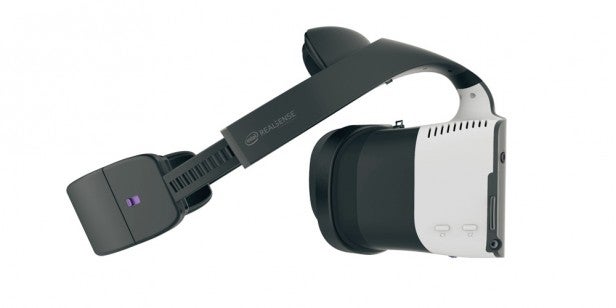
“The number one question most people have after they try the HTC Vive – after asking ‘where are my feet?’ – is ‘how do I lose this cable?’,” Pallister says. “We’ve been working on taking WiGig technology and getting it into a state where the latency is low enough and you can have a robust enough coverage. It’s one thing to have low latency but if as soon as you turn your head it blacks out… it needs to be solid.
“Now it’s in a state where we can get there, we’re talking to partners about who wants to go and produce it. Everyone has to decide whether it’ll be part of the HMD [head-mounted display] or a peripheral.”
Putting a sensor onto a headset to injest the physical world around you seems obvious, but both the Oculus Rift and HTC Vive use slighly faffy external sensors. Perhaps the next generation of VR devices can ditch these altogether and go for an on-headset solution instead.
Intel will be waving the RealSense flag pretty hard if that’s the case.
Related: What is Google Daydream VR?
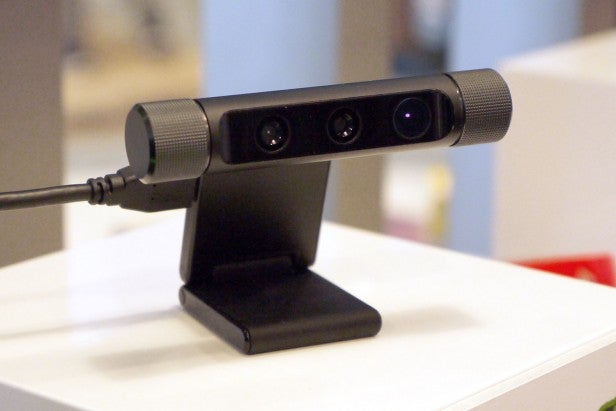
An Intel RealSense camera
Where to next for Intel and VR?
The world of virtual- and mixed-reality is an exciting but confusing one, with most companies currently adopting different approaches.
For instance, Microsoft has doubled down on mixed reality with its Windows Holographic platform and HoloLens display, while the HTC Vive and Valve are all about high-end PC gaming.
Sony and Samsung, on the other hand, are all about making more accessible VR devices, while Facebook-owned Oculus has a mixed bag of mobile and PC VR, and Google has (unsurprisingly) focussed on the potential of mobile-based virtual reality experience. Hell, even Apple VR is a distinct possibility.
Intel, for its part, has opted to push all-in-one Alloy-style headsets. Who’s right? Who knows, but it still has some serious work to do – a challenge I got the impression many at the company were relishing.
The real task for Intel is not to get left behind as the VR market matures, having missed out on making a big impact on the first generation of enthusiast headsets.
As a result, it looks like it is doubling down on what’s to come. With so many different ‘types’ of alternative realities now in the mix – and the industry clearly uncertain about which one will truly take off – Intel has to back every single horse, be it a winner or loser, to gain a foothold.
And based on my time with the company’s VR lead at GDC, I’d say it has got its gambling hat on.
Watch: HTC Vive vs Oculus Rift
Do you think Intel will succeed at cracking VR? Let us know in the comments below.


